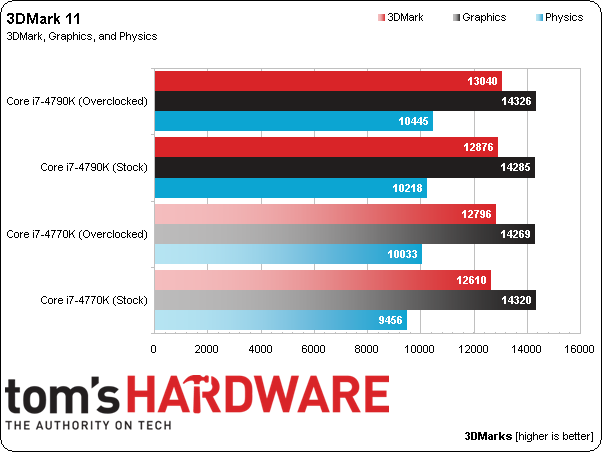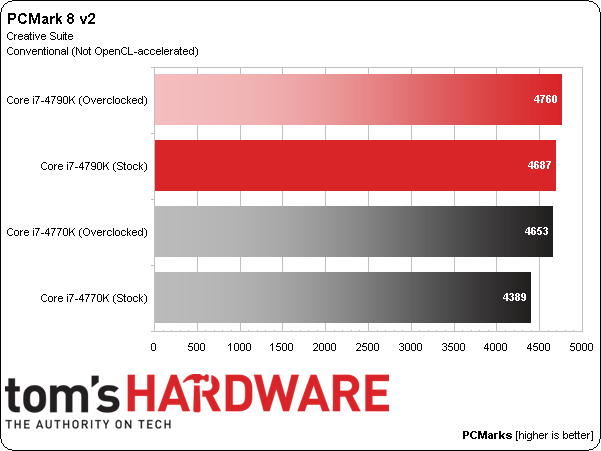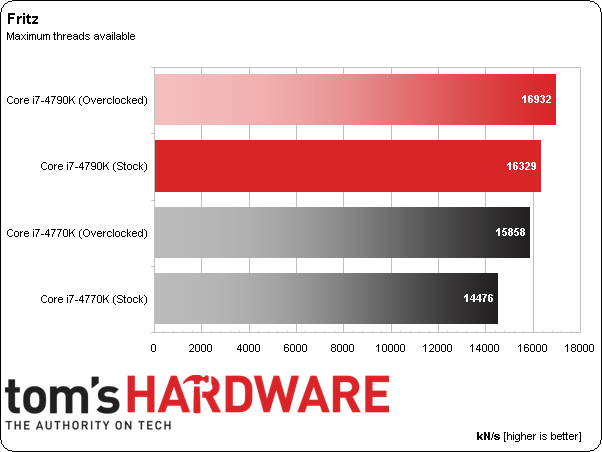Core i7-4790K Review: Devil's Canyon Tantalizes Enthusiasts
Despite a clear performance advantage, Intel just doesn't seem like an enthusiast-friendly company. Certain elements in the organization want to change that perception, though. Devil's Canyon is meant to allay power users with more speed.
Results: Synthetics
Comparing the 3DMark suite score to the Graphics and Physics results shows that CPU performance is what moves the dial. Most notably, a stock Core i7-4790K is faster than our overclocked Core i7-4770K. Given that this test is well-threaded, and both configurations are set up for four-core Turbo Boost settings of 4.2 GHz, the outcome is unexpected. It is something you'll see happen consistently through the rest of our suite, though.
I picked PCMark 8's Creative suite for our little exploration in light of its emphasis on media and content creation (specifically, Web browsing, photo editing, video editing, gaming, and video chat). There are two versions of the benchmark: Conventional and Accelerated, the latter of which employs OpenCL-based acceleration. Because I specifically want to isolate the host processor, though, and not lean on the GeForce GTX Titan in our test machine, these numbers reflect the Conventional run.
The biggest speed-up comes from overclocking a Core i7-4770K from its stock 3.5 GHz up to 4.2 GHz. However, the Core i7-4790K wants to run at 4.2 GHz in its stock form, too, and it yields a bit of extra speed in the process. Pushing up to 4.4 GHz across all four of the 4790K's cores registers a a small speed-up, and you'd expect to see similarly subtle increases as you push the CPU harder.
The results from each processor are reflected in kilonodes per second. A node is a position on the chessboard. So, in the case of Core i7-4790K, Fritz evaluates more than 16,000 thousand nodes per second, or 16 million. In comparison, a Core i7-3930K, operating at its stock frequencies, returns more than 18,000 kN/s, and the Core i7-4960X approaches 20,000. Those CPUs get their advantage from six physical cores, even though they employ older architectures.
Get Tom's Hardware's best news and in-depth reviews, straight to your inbox.
Current page: Results: Synthetics
Prev Page How We Tested Core i7-4790K Next Page Results: Content Creation-
NBSN Really nice read. I am very excited to see how well the i7-4790k performed, and that means in 2-3 years the CPUs that will be out are going to be amazing. It will be nice to start seeing stock clocked 4 GHz to 4.5 GHz Intel CPUs to better keep up with the AMD overclocking that many builders do. I prefer Intel and really feel that they offer the best performance for their CPUs.Reply
I built my PC at the end of last year, beginning of this one and went with a i7-4930k. I really wanted a six core processor and have not been disappointed. I have been itching to build another PC because it was really fun to put the plan of components together and although my hands were to big and my medical conditions prevented me from getting to do a lot of the building, my wife helped a lot with that part and it was nice to see the finished product in action. With that being said, I don't have a lot of money for anything right now and hope that my disability pay finally comes through so I can start picking together parts for a computer for my wife. She won't need anything as powerful as I have, and the i7-4790k sounds pretty sweet. -
BoredErica The average overclock based upon my Google Doc of about 185 overclocks now averages at 4.55ghz for Haswell. A tim change isn't going to gain an extra 200mhz and even then, it's being generous.Reply
On a side note, this website annoys me. I click to add comment and the default fields are for signing up, no logging in, and when I do, I am back to the homepage. Great. -
roymustang It would've been nice to show benchmarks and temps vs sandy bridge (2600K) at same frequency to help us gauge the progress (or the lack of) that's been made in the last three and a half years.Reply -
neon neophyte so one of their biggest selling points ended up resulting in a 6 degree difference.Reply
bring back solder intel. -
Amdlova nice improve :) please where i put my razor? no way 6ºc improve. my ambient temp hits 45ºc my old 3770k 4.6ghz hit 88ºc on core. with this "new shinning old tech" i can't hit the 4.2ghz. intel miss and miss Hard!Reply -
NBSN I think that the whole real point of releasing this new processor and the others to follow it is simple. Intel wants to offer a better stock clock for those that do not want to or do not know how to overclock their processor. And since AMD allows easier overclocking, or at least a whole lot more processors that can be overclocked than the ones that Intel specifies for their own products. This will help a lot of consumers decide Intel over AMD if they continue to offer comparative clocks.Reply -
ssdpro First problem: 6C between the old and new TIM is something, but not much. As one of the big improvement features, that is disappointing.Reply
Second problem: Why is Tom's using 1.275 V for 4200MHz on both units? Is that actually 1.275v with LLC disabled or is LLC on a setting resulting in the lowest load voltage? If one of those units need 1.275v to be stable at 4200 you have a real donkey sample on your hands. Even the worst i7-4770k are stable at 1.20v @ 4200. Or was the over voltage designed to test an unrealistic incompetent situation to either emphasize or DE-emphasize the TIM difference? -
Adroid Sorry, but I'm entirely unimpressed. Improved TIM is a waste of time. I thought this was going to release with fluxless solder. 6° worth the wait ? 6° is the difference between air cooling and water cooling.Reply
Voltage wall is still at the approximate same place. Heat is still the limiting factor. I expect some of the better binned 4670K will hit equal or better than the 4690K.
I'll stay with my 3570K @ 4.3ghz - this clearly isn't much of a step up. Looks like I'm waiting for a DDR4 system in a couple years.



